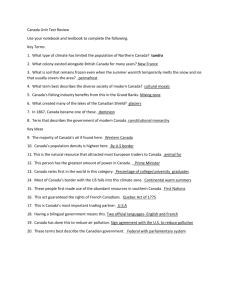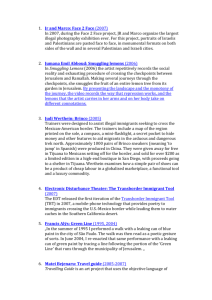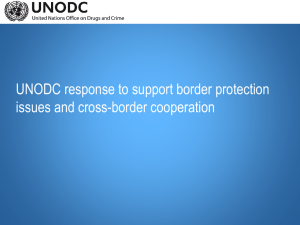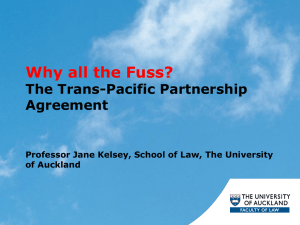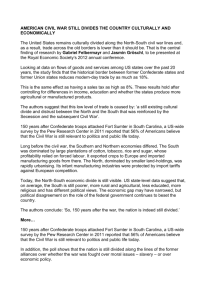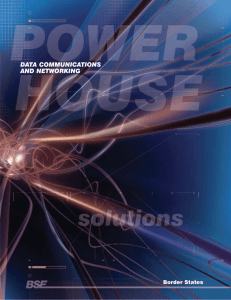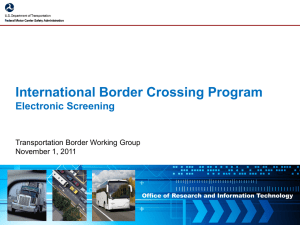Border Policy Research Institute Symposium
advertisement
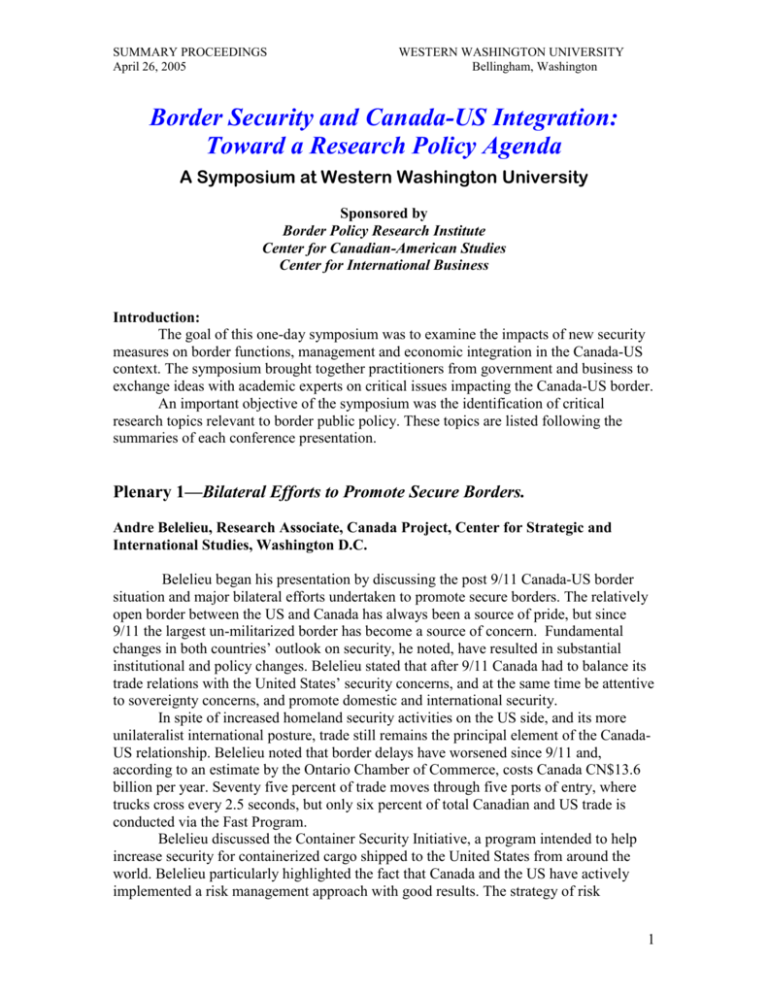
SUMMARY PROCEEDINGS April 26, 2005 WESTERN WASHINGTON UNIVERSITY Bellingham, Washington Border Security and Canada-US Integration: Toward a Research Policy Agenda A Symposium at Western Washington University Sponsored by Border Policy Research Institute Center for Canadian-American Studies Center for International Business Introduction: The goal of this one-day symposium was to examine the impacts of new security measures on border functions, management and economic integration in the Canada-US context. The symposium brought together practitioners from government and business to exchange ideas with academic experts on critical issues impacting the Canada-US border. An important objective of the symposium was the identification of critical research topics relevant to border public policy. These topics are listed following the summaries of each conference presentation. Plenary 1—Bilateral Efforts to Promote Secure Borders. Andre Belelieu, Research Associate, Canada Project, Center for Strategic and International Studies, Washington D.C. Belelieu began his presentation by discussing the post 9/11 Canada-US border situation and major bilateral efforts undertaken to promote secure borders. The relatively open border between the US and Canada has always been a source of pride, but since 9/11 the largest un-militarized border has become a source of concern. Fundamental changes in both countries’ outlook on security, he noted, have resulted in substantial institutional and policy changes. Belelieu stated that after 9/11 Canada had to balance its trade relations with the United States’ security concerns, and at the same time be attentive to sovereignty concerns, and promote domestic and international security. In spite of increased homeland security activities on the US side, and its more unilateralist international posture, trade still remains the principal element of the CanadaUS relationship. Belelieu noted that border delays have worsened since 9/11 and, according to an estimate by the Ontario Chamber of Commerce, costs Canada CN$13.6 billion per year. Seventy five percent of trade moves through five ports of entry, where trucks cross every 2.5 seconds, but only six percent of total Canadian and US trade is conducted via the Fast Program. Belelieu discussed the Container Security Initiative, a program intended to help increase security for containerized cargo shipped to the United States from around the world. Belelieu particularly highlighted the fact that Canada and the US have actively implemented a risk management approach with good results. The strategy of risk 1 SUMMARY PROCEEDINGS April 26, 2005 WESTERN WASHINGTON UNIVERSITY Bellingham, Washington management is simple. Customs has a set of criteria for all shipments and people that determines whether they are high or low risk. This includes factors such as the nature of the goods, the origin of the shipment, or the demonstrated security of the supply chain of the shipping company. For people, risk is often determined by country of origin, criminal records, or by checking databases and watch lists. He noted that Americans now expect that Canada will do more screening of cargo before it comes into the US. The US screens most of the cargo at foreign ports through the Container Security Initiative. Belelieu noted that half the cargo from Halifax and Montreal goes to the US. Similarly, about half the cargo unloaded at Vancouver’s ports is headed for the US. In terms of mobility of people, Belelieu raised the concern that many people are unwilling to give up personal information and are dissatisfied with the passport requirements for the US VISIT. Once the US fully implements the US VISIT program, waiting and delays at the border are likely to increase. Belelieu pointed out many institutional changes in Canada-US relations since 9/11 that reflect broad security concerns; especially important is the creation of Integrated Border Enforcement Teams (IBETS) and Integrated Marine Enforcement Teams (IMETS.) He emphasized that the two countries cannot allow security concerns to interfere with economic progress. Calling for better border management, Belelieu highlighted the importance of building sufficient political capital and the will to improve security and economic agendas. Research Topics for Consideration and Exploration Despite the fact that many scholars, the business community, and governmental bodies proclaim the border as a vital issue for the future prosperity and security of North America, there is comparatively little research on the evolving nature of border policymaking, and its impact on North American integration. This is especially true for the United States, where there are few scholars and experts looking at the border on a sustained basis. More research needs to focus on the border, not only as part of the future of North American integration, but also as an issue on its own. Specific topics for consideration are the following: Bilateral v. trilateral solutions have always preoccupied policymakers in both Canada and Mexico. With the announcement of the Security and Prosperity Partnership of North America, future research should be directed to assessing possibilities for trilateral border management, and areas where this may not be the best solution. Moreover, future research on American attitudes to this issue would be especially helpful in determining what is feasible and what is not. Should Canada and the United States institutionalize the Smart Border process? Is a new framework or declaration needed to guide border policy? Surprisingly, there exists virtually no literature looking at the successes and failures of the Smart Border process since 9-11. More research needs to be undertaken to assess the process and where it needs to head in the future 2 SUMMARY PROCEEDINGS April 26, 2005 WESTERN WASHINGTON UNIVERSITY Bellingham, Washington It is commonplace to point out infrastructure inadequacies and the cost of delays to business. Moreover, it is commonplace to declare that border policymaking favors trade over security, or vice versa, depending on your perspective. Future research that would quantify the costs of border delays would be invaluable. To date several companies and chambers of commerce have issued statistics and estimates of border delays in certain sectors, or sub-state jurisdictions. A larger look at the border in general, and how much it effects trade, would be useful, especially since there is so much ‘just-in-time’ trade in North America Studies that would assess on a large scale the necessary investments needed to upgrade the border to an adequate level could be invaluable in influencing debates on future investments and timetables for infrastructure upgrades. One of the most talked about topics concerning Canada-US border relations is how best to manage the border in the future. Two broad schools of thought influence this debate. On the one hand, there are those who advocate convergence and increased harmonization of border rules with the United States. This is sometimes known as the “Big Bang” approach. On the other hand, there are those who call for an incremental approach to remain the key strategy for moving forward. Future research needs to continue focusing on this area. There is a wealth of literature spanning this debate, often tying the border debate into the larger debate about North American integration. Most of it, however, comes from Canada, and there is little research in the United States. How applicable is the Canada-US model to other parts of the world? On his last trip to Canada, EU Commission President Romano Prodi declared that Europe was interested in adopting the Smart Border model for their internal use, as well as a future framework for relations with the United States. Future research could assess the desirability of such an initiative or could serve as an interesting case study in assessing security relations with the United States in a post-September 11 world. Congress has been, and will continue to be, a key player in moving border policy forward. Future research efforts need to target outreach to Congress through Congressional Border Tours, briefings, and increased interaction with the Northern Border Caucus and the Homeland Security Committee. Center for Strategic and International Studies (CSIS) research has shown that many of the staff working on the issues are not familiar with the border, or the implications of many of the policies. Belelieu noted the increasing role of state-provincial government relations and regional groupings in influencing border policy. More research needs to focus on this phenomenon, and research identifying case studies where regional solutions may be more applicable than national solutions would be a welcome addition to existing research. Additional research focusing on some of the key actors outside of Washington and Ottawa would be useful in helping people understand some of the key players in 3 SUMMARY PROCEEDINGS April 26, 2005 WESTERN WASHINGTON UNIVERSITY Bellingham, Washington border policymaking that often go unnoticed, and some of the key regional issues that often get lost with “one size fits all” national solutions. Plenary 2— The Linkages Between Border Security and Economic Integration Danielle Goldfarb, Senior Policy Analyst, C.D. Howe Institute, Toronto Goldfarb’s central theme was the effect of border security on a shared CanadaUS economic space. She began by pointing out that not only do security measures affect prosperity but that security is critical to prosperity. Trade and investment thrive in predictable, secure environments. She noted that the key challenge was ensuring that domestic and regional physical security measures reinforce the security of the shared economic space to ensure that prosperity in both societies is not eroded. Goldfarb described the integrated nature of the two economies, in which one-third of exports are import content and much trade is in intermediate inputs. Given the nature of this trade, and the fact that goods and people crisscross borders multiple times, even small increases in border barriers for security or other reasons can have large consequences. Perceptions of small increases in border barriers can matter just as much as actual increases. She also noted that a border rendered less predictable by border security policies makes it very difficult for cross-border supply chains to function effectively. Goldfarb pointed out that some industries are more vulnerable to border problems than others. Goods likely to be most vulnerable are those shipped by truck, those that rely on ‘just-in-time’ logistics or are perishable and those that involve imported items that are then exported. If parts cannot be imported, the entire product cannot be exported. Thus, manufacturers who cannot rely on predictable and efficient border transitions may choose to invest on the US side of the border where they can produce their entire product and sell to the world’s largest market without having to cross a border. Or they may choose to locate plants outside of North America altogether. Goldfarb added that since a more impenetrable border could lead to investment gains in the US, there is a danger for Canada that in the US powerful security and protectionist interests could join forces to call for tighter border controls. Goldfarb highlighted preliminary evidence that the border had become slightly thicker and more unpredictable and that this mattered for both Canadian and US prosperity. She concluded that both countries must work together to address security in ways sensitive to the highly integrated regional economic space. Policymakers should not use security as an excuse to restrict companies’ abilities to source across the border. Research Topics for Consideration and Exploration As time passes, it may be possible to better discern the effects of border security policies on trade, investment, inventories, margins, incomes, employment, etc. A key limitation, however, is the difficulty of separating out the border effect from the overall economic situation. 4 SUMMARY PROCEEDINGS April 26, 2005 WESTERN WASHINGTON UNIVERSITY Bellingham, Washington Research should focus on the impact of security measures on vulnerable goods, industries and modes of transportation, ie., trucks, power lines, perishable goods and goods that involve imported items which are then exported. More research is needed on the effect of border security measures on travel and workrelated movements of people. It is important to examine the interaction between border security changes and global supply chains—as well as China’s economic rise. If security of supply chains can not be guaranteed globally, companies may have to source locally at higher costs, with implications for competitiveness. Panel 1: The Impacts of 9/11: Practitioners’ Perspective Immigration Greg Boos, Attorney, Chang and Boos LLP, Bellingham, WA A major premise of Boos’ presentation was that the US immigration system is in need of repair. He spoke of an anti-immigrant mood in US politics and gave examples, such as significant reductions in H1B and H2B visas and restrictions placed on L1 visas since 9/11. Boos pointed out that such reductions/restrictions harm the Whatcom County economy given the large number of Canadian-owned companies operating in the county and the need for these businesses to access key employees in Canada. Boos also shared written comments that he prepared for the Pacific Corridor Enterprise Council (PACE) and the American Immigration Lawyers Association (AILA) in response to a Draft Environmental Assessment filed by DHS for testing US VISIT land border exit processes to take place at Whatcom County border crossings, beginning in June 2005. He cited three government reports in support of his comments suggesting that US VISIT has a poor track record to date, and that it may have an adverse effect on the local economy. Boos pointed out that once US VISIT has been fully implemented 31 USC §9701, 8 CFR §235.7(a)(5)(iii), OMB Circular A-25 and other provisions of law mandate that user fees sufficient to cover the costs of such technology and its administration are to be charged to the users of the programs. Boos suggested that DHS in its intent to make the program self-sustaining may be designing US VISIT without concern about the amount of the user fee and the effect of the user fee on legitimate cross-border trade and travel. Boos also pointed out that on the northern border, other than US citizens, Canadian citizens form the largest number of border crossers. At present, for technical reasons established in the Data Integrity and Management Act, most Canadian citizens are exempt from US VISIT’s requirements and are not subject to payment of a fee when crossing the border. However, at a US VISIT stakeholders meeting held in Bellingham 5 SUMMARY PROCEEDINGS April 26, 2005 WESTERN WASHINGTON UNIVERSITY Bellingham, Washington WA on January 25, 2005, DHS announced that it is exploring enrolling Canadian citizens into US VISIT in 2008 when a provision of The Intelligence Reform and Terrorism Prevention Act of 2004 takes effect that will require Canadian citizens to use passports containing certain biometric information when entering the US. If this happens Canadian entries into the US may no longer be fee exempt. Research Topics for Consideration and Exploration The economic impact of Canadian owned businesses operating in Whatcom County needs to be determined. The exact number of these businesses and their impact on the local economy is unknown. The impact of restrictive US visa processes on these businesses needs to be determined. Future increases in the cost of cross-border travel in the form of increased user fees charged to individuals who are required to register in the US VISIT program may impact cross-border travel. How much will foreign travelers be willing to pay at the border for entry into the US? It is crucial to establish facts and figures to uncover real costs and benefits of this program. What will be the effect on cross-border trade and commerce if Canadians are required to enroll in US VISIT? Will such enrollment (and payment of fee) deter Canadians from visiting the US? Transportation/Shipping/Market Access Jim Pettinger, President, International Market Access, Inc. In his presentation, Pettinger focused on the impacts of 9/11 on transportation, shipping and market access. He stated, that tourism was one of the industries that was hit the hardest after 9/11. Because of this, he stressed the need for people in the region to participate and communicate with local and regional groups, such as local chambers of commerce, Pacific Corridor Enterprise Council (PACE), International Mobility and Trade Corridor (IMTC) and others to influence the public debate on border management with a view to making policy more effective. In his view, it was much more productive for small and medium sized businesses to try to cooperate rather than fight the system. Pettinger noted that 9/11 and increased security brought some positive cross-border commercial changes. For one, there has been an increase in the number of staff dealing with commercial issues, a more knowledgeable staff and the introduction of new systems and technology that expedite trade. He was optimistic that the border will operate better than ever before. 6 SUMMARY PROCEEDINGS April 26, 2005 WESTERN WASHINGTON UNIVERSITY Bellingham, Washington Security Procedures Bill Ard, Superintendent and Officer in Charge, RCMP E Division Border Integrity Ard pointed out that the RCMP is advantaged in its risk management efforts because of its centrality in policing at the Federal, provincial and city levels. RCMP is the provincial police for 11 provinces and territories. Its advantage is in its ability to collect and share information. Ard observed that there are significant differences in seizures of marijuana and cocaine that is being transported across the border between Canada and the US. He cited the following statistics: five million dollars worth of marijuana destined for the US has been seized and two hundred million dollars of cocaine destined for Canada has been seized. Because both countries have a legitimate interest in controlling the cross border movement of drugs, a joint risk management approach is necessary. Such an approach is best handled through information sharing and cooperative work at the border. For this reason, a significant disadvantage to moving Customs clearance of commodities away from the border is the high risk of drugs crossing the border at the Ports of Entry. Ard spoke about Integrated Border Enforcement Team (IBET) in Blaine which is a good example of efficient cooperation between two countries. The model is built on the premise of partnership, and on sharing collected intelligence more effectively to target cross-border criminal activity. Each agency conducts their own checks and then shares the information with the other. Also emphasized was the importance of border activities at the ports. One of the major examples is the Prince Rupert Port Initiative, where goods can arrive as much as two days earlier than any other West Coast port. The RCMP works at the port to head off crime, illegal activity, etc. Their major goal is to conduct security operations at West Coast ports. He concluded that considering new security realities, the European Schengen convention should be assessed for potential application to the Canada-US relationship to allow for international designation of some law enforcement personnel to have law enforcement authority on both sides of the border, including the ability to gather evidence in either country. Panel 2: The Impacts of 9/11: Research Roundtable Immigration: A Regional Perspective Don J. DeVoretz, Co-Director, Centre of Excellence on Immigration Studies and Professor of Economics, Simon Fraser University Introduction Canada has been preoccupied since September 11th, 2001 with the implications of increased United States border security on its immigration and trade flows. This preoccupation has led to a variety of queries. For example, how will Canada’s refugee policy be changed by increased border scrutiny? Will TN visas be more difficult to obtain for naturalized Canadians? Will opportunities arise in Canada as a result of this increased United States border scrutiny? Will Canada receive more foreign visitors? Can Canada 7 SUMMARY PROCEEDINGS April 26, 2005 WESTERN WASHINGTON UNIVERSITY Bellingham, Washington gain a comparative advantage in attracting foreign students normally destined to the United States? Will Canada’s ‘brain drain’ to the United States be dampened by heightened security measures? One common thread occurs across all these conjectures, namely there are few answers to these questions available circa 2005. Sources of Deflection Economists typically look for indirect effects whenever a quota or restraint is applied at a border. Thus, both the unilateral measures that the United States has undertaken to enhance its border security and the resulting reactions of Canada in its admission policies for immigrants may lead to deflection of immigrants. Deflection is defined as increased movement north to Canada from the United States or vice-versa. The various entry categories are mentioned below to illustrate how this deflection effect arises. Safe Third Country Agreement The “Safe Third Country Agreement” is one direct outcome of the extended Canadian-United States negotiations to ensure mutual border security. This Canadian inspired agreement stipulates that a refugee declaration must be made in either Canada or the United States, depending on the initial landing point of the refugee. The issue from a Canadian viewpoint is that this procedure will in fact make United States standards of refugee admission the North American norm, since the majority of North America bound refugees land initially in the United States. The question at hand for this conference is not the inherent loss in Canadian sovereignty but the possible deflection of refugees. For example, what evidence exists today to suggest that refugee applicants for admission to Canada have declined? Moreover, how many of these rejected refugees at the United States border would have been admissible in Canada? In short, has the “Safe Third Country Agreement” made a difference in deflecting bone fide Canadian bound refugees at the United States border? Since the “Safe Third Country Agreement” has only been in effect since the beginning of 2005, it is premature to answer these questions except to note that Canadian refugee applications are down substantially in first quarter of 2005. At this point it is important to note that the genesis of this “Safe Third Country Agreement” is actually found in Europe, and that the North American initiative to this policy has been almost exclusively a Canadian one. Nonetheless, the implementation of the “Safe Third Country Agreement” is predicated on the proposition that there are gains to both countries from this protocol which presumably enhances border security at the expense of Canadian sovereignty and refugee human rights. Foreign Students Canada has long been concerned with its relatively low number of foreign students (about 100,000) resident in Canada when compared to the numbers in the United States and more particularly Australia. Canada’s desire to increase the number of foreign 8 SUMMARY PROCEEDINGS April 26, 2005 WESTERN WASHINGTON UNIVERSITY Bellingham, Washington students is driven by two forces. First, Canada wants to increase its university enrollment but, more importantly, foreign students are thought of as a possible source of permanent highly skilled immigrants for its labour force. However, Canada’s attempt to increase foreign student enrollment have been thwarted by competitive pressures and the fear of being accused of accelerating the ‘brain drain’. Canada has recently dropped its concerns about adding to the ‘brain drain’ and views foreign student movement as part of a ‘brain circulation’ movement. Given that Canada and the world now accept the less emotive ‘brain circulation argument’, it has become politically feasible to deflect foreign students from the United States to Canada. In fact, Canada has recently encouraged this alleged deflection with an imaginative policy response. Specifically, Canada now will allow foreign students to apply for permanent residence status after graduation without leaving Canada. This minor change, coupled with tighter United States security efforts, may enhance foreign student deflection from the United States to Canada, and may also increase the number of Chinese (and other) applicants who never consider the United States as their first choice. TN Visa Holders As an addendum to the NAFTA accord, Canada and the United States created the trade or TN visa which allows temporary (one year) residence for its citizens in a limited number of occupations. This visa had become the favored mechanism to enter the United States for those Canadians who qualified prior to 9/11. However, citizenship is a key criterion for eligibility for the TN visa, and a significant number of Canadian skilled immigrants are not eligible until they become citizens. In addition, recent tightened United States visa requirements for Canadian immigrants from select countries (Iran, Pakistan, etc.) may have decreased their mobility given their country of birth status. The fact that the United States uses country of birth and not country of citizenship as the location criterion to deport undesirables has had a chilling effect on those Canadian citizens who previously migrated from terrorist-producing states and are now naturalized Canadian citizens. In addition, the employers of these naturalized Canadian citizens recognize their employees’ increased vulnerability if they are naturalized citizens from terrorist-producing states. Again, the unproven supposition is that there exists a “chill effect” on cross border mobility and the use of TN visas. Northern Permanent Flows The United States has a large pool of legal temporary immigrants whose legal residence status is in doubt and they may respond to increased internal scrutiny by choosing to emigrate to Canada. Two visa types which may be affected and subject to northern deflection to Canada are current US resident foreign students and H1-B visa holders. There is, again, limited anecdotal evidence that H1-B visa holders who lost their 9 SUMMARY PROCEEDINGS April 26, 2005 WESTERN WASHINGTON UNIVERSITY Bellingham, Washington jobs in the United States have applied for permanent residency in Canada rather than violating their United States visa condition or returning home. Moreover, graduating United States foreign students have applied to enter Canada to both further their education and gain permanent residence status in Canada. Conclusions and Research Topics for Consideration and Exploration In sum, it can be argued that although enhanced United States scrutiny at the border has been quite minimal to date, immigration flows to Canada across a variety of entry categories from refugees to highly talented foreign students may be rising. This conclusion suggests a host of research questions including: Has the composition, size and origin of refugees changed for either the United States or Canada, or both countries under the “Safe Third Country Agreement”? Given the above, is there an analytical framework to assess the gain in security from any diminution in refugee claims? Has there been a deflection of foreign students to Canada and at what level; graduate or undergraduate? If there exists a deflection, have the best or the mediocre students been deflected to Canada? Have these students remained in Canada to become permanent residents or have they moved on? Have former H1-B or other temporary US visa holders applied for permanent Canadian resident status? Has there been an increase in Canadian immigrant applicants from mid-eastern countries which are subject to special United States scrutiny? What lessons can North America learn from the European Union experience under a common border scheme with 26 distinct immigration policies? Does varying security scrutiny across entry gates result in substitution in immigrant applications across entry gates? Transportation/Shipping/Market Access John Taylor, Associate Professor, Seidman College of Business, Grand Valley State University The substantial cost of the border to Canadian and US industry and personal travelers was the main theme of Taylor’s presentation. He stated that the trade growth 10 SUMMARY PROCEEDINGS April 26, 2005 WESTERN WASHINGTON UNIVERSITY Bellingham, Washington rate has not only slowed since 2000, but there is also a steady decline in actual auto traffic, and no growth in truck traffic after years of rapid growth. Taylor’s research team quantified a range of cost estimates related to actual transit time and uncertainty at the border, including specific and general cost items. In total, overall border costs are estimated to vary from US$7.52 billion to US$13.2 billion, with a mid-range estimate of US$10.3 billion. Costs specifically related to transit time delays and uncertainty about transit times are estimated to be US$4.01 billion. Taylor noted that a major subcategory of these costs is related to manufacturers who suffer a reduction in productivity due to less cross-border sourcing from preferred suppliers. He estimated that these costs total US$1.53 billion per year. In addition to delay costs, there are also costs related to administration of border processing procedures, brokerage, cabotage, duties, and other border policy related costs. These costs are estimated to total US$6.3 billion, and in combination with the US$4.01 billion in delay costs, result in the mid range estimate of a US$10.3 billion cost of the border. In terms of border security, Taylor said even with tougher measures at key crossings, real security is problematic given the number of vehicles crossing the border and the time spent per vehicle. In addition, there are many rural crossing points that are not staffed, further complicating the provision of significant security. Taylor stated that pushing the security perimeter outward to first points of entry, with a de-emphasis of routine screening of all travelers on the Canadian-US border itself, could free up resources for more effective security measures at airports and ports, while facilitating trade. In concluding remarks, Taylor stated that the United States and Canada will need to consider substantial changes in border management strategies if enhanced security and trade facilitation are to maintain equilibrium. Research Topics for Consideration and Exploration In order to determine the future direction of border management in the continuously changing policy environment, refinement of estimates of the actual costs of the border (ex. brokerage costs, transit times and uncertainty costs, etc.) is imperative. Specific areas requiring research involve: o The costs to manufacturers for brokerage o The costs to manufacturers for customs administration o The costs to carriers for customs administration o The costs to carriers for cabotage regulations Research should assist Canadian Customs to improve the accuracy of the border delay monitoring they track every three hours, and quarterly summaries of the average backups times at major crossings and border-wide. The overall costs of the border should be recalculated annually. With annual estimates, we can better estimate the cost impact of proposed or recently implemented border security measures. There also needs to be research to quantify the level of security benefit provided by new border security measures. 11 SUMMARY PROCEEDINGS April 26, 2005 WESTERN WASHINGTON UNIVERSITY Bellingham, Washington The Role of Borders in Enhancing Security Margaret Stock, Professor Law, U.S. Military Academy, West Point, NY Margaret Stock began her presentation by highlighting the connection between immigration and border security. The US government must be more affirmative in letting the “right people” in and retaining them. Currently Canada is better at this approach. The Department of Homeland Security ignores this affirmative approach. Furthermore, the present US immigration system is dysfunctional. She highlighted that the system is not proficient at distinguishing between bad and good immigrants. In addition, the US government does not have the resources to deport the 8 to 20 million illegal aliens who are present in the United States today. The government does not use immigrants effectively as an instrument in the fight against terrorism. She suggested that the US government should utilize immigrants to get information on terrorist plans, instead of employing the philosophy of simply keeping people out. There are also economic and political dimensions of security that should be kept in mind. Stock indicated that it will be interesting to examine how Canada is approaching these issues. There is a crucial need to better align two countries’ approaches and cooperate for the common good. Research Topics Consideration and Exploration New technological solutions have been introduced in border management since 9/11. However, the new security measures create security costs and dangers. For example, large and centralized databases could be exploited by insiders, hackers, etc. There is a need to research how these costs and dangers can be alleviated. Major changes in governmental structures and processes that address the current national security climate may not all produce the best outcomes. It is crucial to examine whether technological innovations are displacing needed human intelligence and where the priority should be placed. Securing the border is intended to protect the well being of the citizens of the two countries, but not all programs intended to achieve this goal produce the best outcomes. Therefore, research is needed on what programs are going to produce the most effective results for the least amount of financial cost. The current pace of investment in infrastructure and innovation at the Canada-US border is not up to the challenge posed by today’s environment. To what extent can privatization help in solving this challenge? Improving security measures at the border inevitably involves creative thinking and more efficient use of resources. There is a need for a detailed cross-national cost/benefit analysis of these new security measures in relation to their effect on trade, migration, and security. 12
